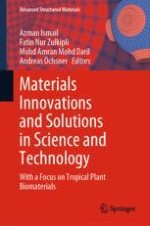2023 | OriginalPaper | Buchkapitel
21. Characterization of Oil Palm Frond-Based Biochar-Filled-Recycled PET Bio-composites
verfasst von : Khaliesah Abbas, Robert Thomas Bachmann, Siew Kooi Ong, Mohamad Fauzi Abraham, Wei Hong Wu, Jason Shiing Lik Ling, Ho Cheng How
Erschienen in: Materials Innovations and Solutions in Science and Technology
Verlag: Springer Nature Switzerland
Aktivieren Sie unsere intelligente Suche, um passende Fachinhalte oder Patente zu finden.
Wählen Sie Textabschnitte aus um mit Künstlicher Intelligenz passenden Patente zu finden. powered by
Markieren Sie Textabschnitte, um KI-gestützt weitere passende Inhalte zu finden. powered by
